Everything happened in Athens over two and a half thousand years ago, and at first it looked only like a drama of a bride. In fact, it was about homosexual revenge that changed the fate of the ancient world ...
The thing takes place in the 6th century BCE. One day, the Athenian authorities called on one of the girls living in polis to perform an honorable role during the Panathenai ceremony, dedicated to the patron saint of the city - Athena. As a so-called kanefora, she was supposed to carry a basket with offerings for the goddess on her head during the procession, paying tribute to her and commemorating her mythical birth.
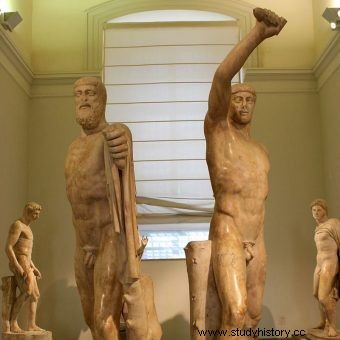
Two men in love with each other who, out of vengeance for humiliation and jealousy, decided to overthrow the Athenian tyrant. In the illustration, a fragment of the so-called "Tyrankiller Group" (depicting a famous couple), considered the first historical monument in Athens and a symbol of democracy.
However, the girl did not have time to enjoy this distinction for a long time. Suddenly, the Athenian authorities said that it was a mistake and that it was not worthy of being honored. It was a terrible humiliation for both her and all her family, What could have been the cause of such an insult?
The truth quickly emerged. Hipparchus, a tyrant shaking Athens alongside his older brother Hippias since the death of their predecessor and father, Pisistratus, in 527 BCE was responsible for the affair with the unfortunate girl. The cause of the scandal was… the ruler's unrequited feeling. But not to the girl - as one might suspect, but to her brother Harmodios . His sister's humiliation was going to hit him and his honor.
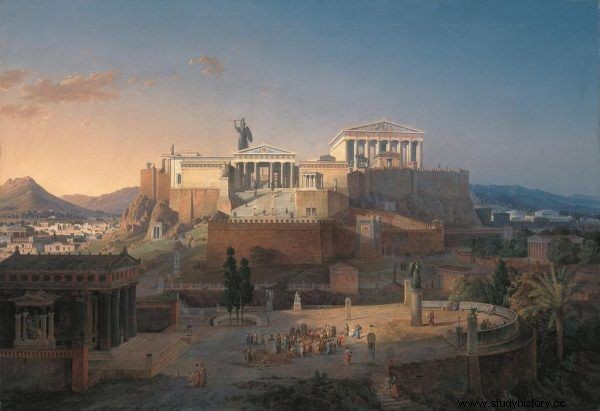
Panatenaje was a festival commemorating the birth of the goddess Athena. One of the greatest honors that could befall an Athenian maiden was taking part in the ceremony as the so-called canoehorse. The illustration shows the Acropolis - a reconstruction of the place of worship of the goddess Athena according to Leo von Klenze.
The tyrant chose the beautiful aristocrat Harmodios - just as in the myths Zeus loved Ganymede and like many Athenians of that time he took a liking to young boys. Yet Harmodios, unaware of what honor had kicked him, stubbornly rejected the king's advances. He preferred Aristogejton, a middle-class Athenian citizen, to whom he quickly revealed how forcefully Hipparchus was imposing himself on him. Aristogeiton was indignant and, at the same time, frightened that the tyrant might try to take his beloved by force. The tension grew.
Meanwhile, Hipparchus was raging:not only did he drive Sister Harmodios away from the Panathenaean procession, but he also accused him of being effeminate. It could have manifested in a variety of ways, such as pleasure in being a passive partner during male-to-male intercourse. And this definitely did not suit the Athenian!
According to the rules prevailing at that time, an Athenian citizen could be adored. He could also allow his older partner to satisfy himself between his thighs. However, he absolutely should not derive pleasure from such close-ups, because it was only fit for women who, according to the Greeks, were unable to control themselves ...

Today we associate Spartans primarily with heroism and ... homosexuality. Was it really so? The illustration shows the painting by Jacques-Louis David "Leonidas at Thermopylae".
Repeatedly insulted, Harmodios and outraged Aristogeiton joined the opposition to the tyrants and began to plan a plot. Hipparchus suspected nothing. Although he and his brother were called tyrants, their rule did not arouse hatred among most Athenians. The brothers embellished the city and had quite a good reputation among the citizens. Hipparchus himself was considered calmer than Hippias. Anyway, he only helped his older brother, who was de facto at the helm of governments.
Meanwhile, the conspirators decided to attack the tyrants on the Panathenai festival. Harmodios and Aristogejton volunteered for the performers. Target number one was Hippias, who wielded power and tolerated his brother's antics. The ruler was accompanied by armed guards, but the assassins were ready for anything. They had daggers ready, hidden in the branches of myrtle. They were about to attack Hippias when they suddenly noticed that one of their conspiratorial acquaintances was having a friendly conversation with the tyrant. They got scared that he might betray their plans and quickly backed off.
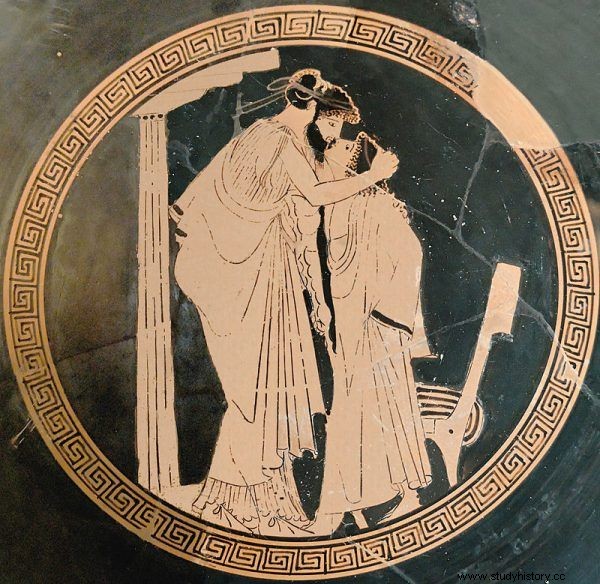
Who would have thought that mere human jealousy could inspire a desire for a coup? As you can see, the ancients succumbed to emotions, regardless of the consequences, especially when it came to love ... The illustration shows a fragment of the Attic kyliks (a vessel for drinking wine) depicting lovers.
So when it was going to fail, on the way the men encountered… Hipparchus himself, responsible for all the insults Harmodios and his family had suffered. Emotions were also heated by Aristogayton's jealousy for his lover, and probably by the sense of disappointment of both bombers that they had failed in the planned attack on Hippias, the official ruler of Athens.
They did not think for a long time. Outraged, they rushed at Hipparchus and stabbed him. By the time the people converged and the guards arrived, the man was already dead. However, the guards soon caught up with Harmodios. The bomber was killed on the spot. Aristogejton managed to escape, but not for long. He was soon captured and taken to torture . He spilled names like on a sleeve. Only after that it turned out that he accused people known to be sympathetic to tyrants (although it is possible that he really could not stand the torture and had betrayed some friends as well).
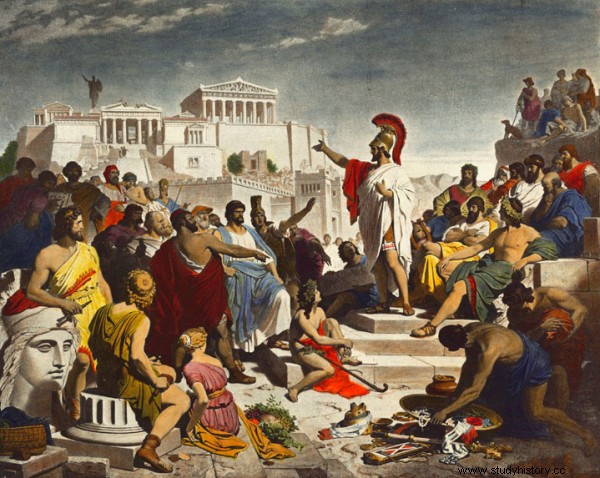
Democracy in Athens is primarily associated with the name of Pericles (illustrated by Philipp Foltz), a politician, rhetorician and reformer of Athenian democracy. Its creation, however, dates back to the 6th century BCE, when two "tyranocides" assassinated one of Pizystrat's sons, Hipparchus.
Aristogeiton was already so tortured that he wanted death. But no one wanted to ease his suffering. So he asked Hippias to give him his right hand as a sign of good faith. When the ruler did so, the man mocked him for just shaking the hand of his brother's killer. The tyrant could not stand it anymore - he reached for a dagger and murdered the prisoner. It was 514 B.C.
Lioness yes, sister no
Aristogiton and Harmodios died, but achieved a moral victory. Successive generations of Athenians venerated them as tyrankers, heroes of Athenian democracy. In fact, Hippias was not deposed until four years later (in 510 B.C.E.), with the help of the Spartans. The tyrant then fled to the Persians. He tried to return to Athens when Greece was attacked by the Persian army of Darius, but the victorious battle of Marathon (490 BCE) brought the Athenians a respite. Democracy could finally flourish.
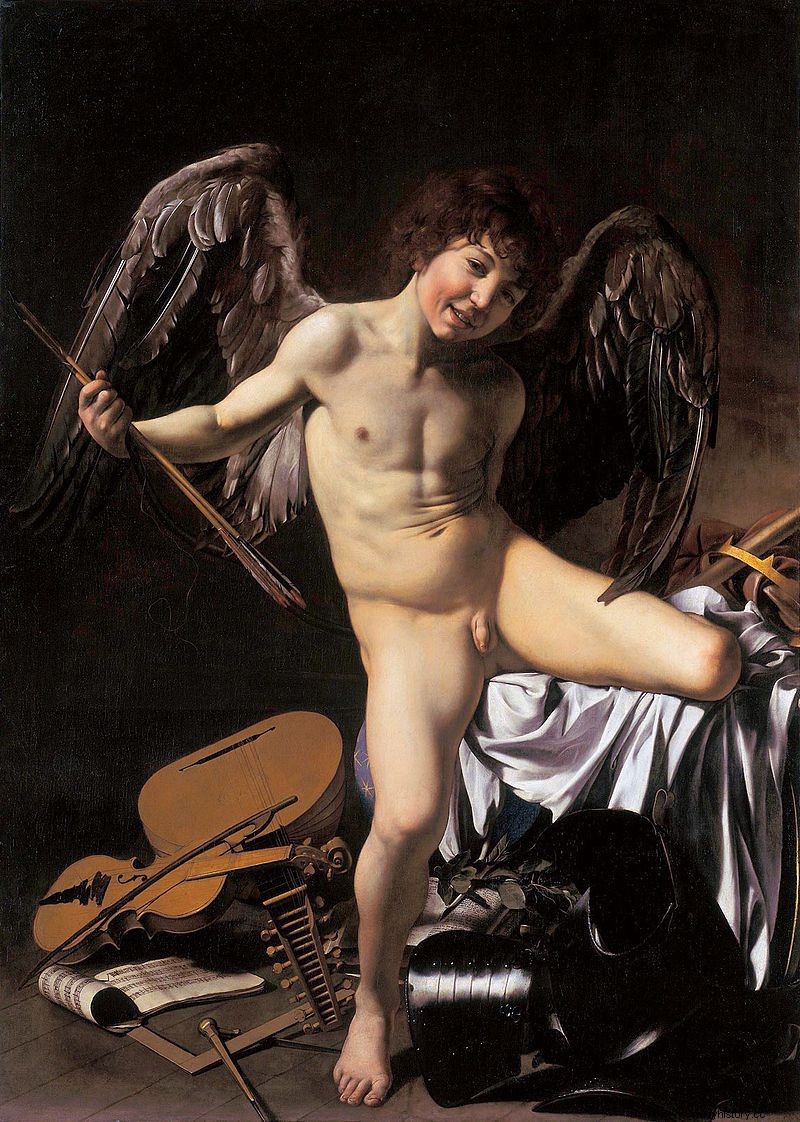
Caravaggio's "Amor Vincit Omnia" (Love will conquer all) is often interpreted as an idealized expression of pederastic love. Her first symbol, however, was a pair of Athenian men, Harmodios and Aristogejton.
The tyrant killers - though they seem to have acted for more personal than political reasons - have got songs and monuments. Harmodios and Aristogejton have become symbols of democracy and equality. But also pederasty (Greek paiderastia that is, love for boys). This one has been associated with the aristocracy so far, which could cause the resentment of the rest of the citizens. Thanks to them, it suddenly gained recognition in the eyes of the Athenians. Harmodios and Aristogejton became proof of the great value of relationships between men.
It is significant that history does not remember the name of the offended sister Harmodios, the sad heroine of the background. More was remembered about Leajna - a chic prostitute (heter) and a good friend of the tyrannical killers who - in order not to betray the members of the conspiracy - bit off her tongue during the interrogation . Pliny the Elder described the monument to the Lioness by Amfikrates, erected in honor of the Athenian call-girl:
The Athenians, wanting to give her a recognition, and unable to glorify publicly hetery, erected a statue of an animal of the same name (...). In order to show the reason for such a distinction, they ordered the artist not to use language for the figure .
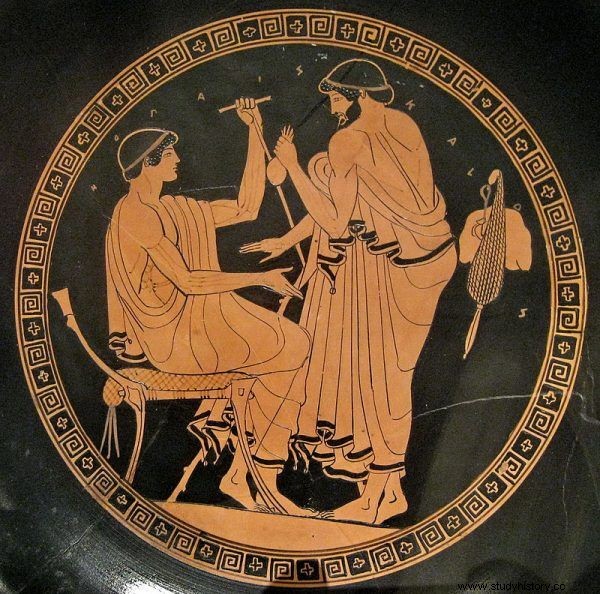
A man trying to persuade a young boy to have sex for a reward. As you can see, even pederasty, idealized by the Greeks, was often mixed up with prostitution ... The illustration shows a fragment of the Attic Kylix.
The lioness did not, however, overshadow the monument to tyranicides - the first historical monument of this type in Athens. When in 480 BCE The Persian army of Xerxes entered the city and plundered the work, the people of Athens erected a new one.
From what brought Aristogayton and Harmodius together, they made a model for a relationship that shaped the body, spirit and civic attitude of the Athenians. Although pederasty already existed before, it gained monumental saints along with the tyrannical killers . As it turns out, with dire consequences for women. Well, maybe apart from Leajna's friends…
***
The text was created during the author's work on his latest book. " Ages of shame. Sex and erotica in antiquity ” .
